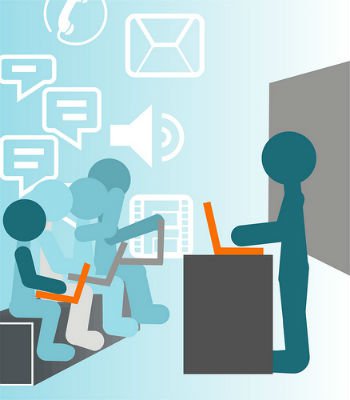Online Training
Build Online Training
With powerful new tools like learning management systems, building online training courses is easy.
In sounds contradictory, but the first step to developing an online course — whether it’s for general education or specific training — is to forget that it’s an online course. Technology may dictate the medium by which educational content is delivered, but it can’t help with the fundamentals. To put it another way: Before painting a masterpiece, you must first learn how to draw.
 Not every online course is going to be a masterpiece, but the spirit of that notion still applies. There are some choices to be made at the start, just as there would have been under the old model, that will at least partly dictate technological decisions down the line. Let’s walk through some useful steps for creating a good online course.
Not every online course is going to be a masterpiece, but the spirit of that notion still applies. There are some choices to be made at the start, just as there would have been under the old model, that will at least partly dictate technological decisions down the line. Let’s walk through some useful steps for creating a good online course.
It Starts with Questions
Take the time to figure out what you need, and then you can figure out how you want to obtain it. Ask yourself:
Who is going to take this class?
- What should they already know, and what should they know after the course is over?
- How much time do I have with these students, and when?
- What sort of resources do I have for presenting the class, and them for taking it?
The answers to these questions may be obvious to you, and all the better if they are. But the answers are the bedrock for writing up a syllabus (or even penciling out an outline, if the situation is more informal), making choices about materials, and developing methods for evaluating or grading trainees.
The Medium Changes the Message
Prior to e-learning technologies, educators and trainers would take the answers to the questions and begin to develop course materials. In retrospect, the choices look pretty limited:
- Syllabus and class schedule.
- Lectures, at least in outline form.
- Overhead transparencies to accompany lectures, or for a classroom to work through a single problem as a group.
- Paper handouts that provide additional illustrative examples of lessons, or practice problems in which pupils must apply the material from the textbook and lectures.
- Quizzes and tests.
The technology that’s now easily available transforms every one of those steps, giving educators and trainers far more power and flexibility to get their lessons across. For example:
- A syllabus can still be a useful tool to help instructors organize their thoughts into a linear class structure, but it’s less critical for the students as the very structure of the course can guide students on a straight line through the material.
- An outline of what lectures are going to be about can still be useful for organizing your thoughts, but can also be woven into the presentation materials for the class.
- Overhead transparencies are replaced with common forms of digital media (e.g., photos, audio recordings, PowerPoint presentations, movie clips, even actions on your own monitor), which are much more portable and don’t require specialized materials.
- Additional information that’s not embedded in original course material can easily be distributed as e-mail attachments or linked to from within the coursework, and it’s up to each student to decide if printing to paper is even necessary.
- A good learning management system (LMS) will include a method for embedding quizzes into the online course materials, which should include a system for grading materials and notifying student of grades.
- In the case of many training programs, certification is the goal, which can also easily be managed through the same interface as the course.
The e-learning industry is rapidly evolving in the direction of even more powerful tools to put greater flexibility into the hands of instructors and trainers. Use these tools to your advantage, and while you may not get a masterpiece on your first try, you’ll be well on your way.
Image used under Creative Commons by Flickr user algogenius.
More Online Training Resources